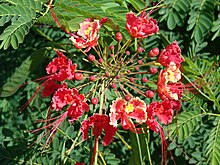Caesalpinia
| Caesalpinia | |
|---|---|

| |
| Caesalpinia pulcherrima | |
| Scientific classification | |
| Kingdom: | Plantae
|
| (unranked): | Angiosperms
|
| (unranked): | |
| (unranked): | |
| Order: | |
| Family: | |
| Subfamily: | |
| Tribe: | |
| Genus: | Caesalpinia (L. 1753) E. Gagnon & G. P. Lewis 2016
|
| Type species | |
L.[3]
| |
| Species | |
|
See text. | |
| Synonyms[4] | |
| |
Caesalpinia is a genus of flowering plants in the legume family, Fabaceae. Historically, membership within the genus has been highly variable, with different publications including anywhere from 70 to 165 species, depending largely on the inclusion or exclusion of species alternately listed under genera such as Hoffmannseggia. It contains tropical or subtropical woody plants. The generic name honours the botanist, physician, and philosopher Andrea Cesalpino (1519–1603).[5]
The name Caesalpinaceae at family level, or Caesalpinioideae at the level of subfamily, is based on this generic name.
Species[]
- Standl.
- Urb.
- Lam.
- Urb.
- L.
- Willd. 1809
- Chiov.
- Britton—Black nicker
- Urb.
- Caesalpinia pulcherrima (L. 1753) Sw. 1791—Pride of Barbados, Yellow Peacock
- Urb.
- Du Puy & Rabev.
- R. Wilczek
- Hance
- Gillis & Proctor
- Hattink
- Harms
- Handel-Mazzetti
- Roxb.
- L. emend. Dandy & Exell—Gray nicker
- S. J. Li, Z. Y. Chen & D. X. Zhang
- Chun & How
- Merr.
- Perr.
- Metcalf
- (L.) Ait.
- (Lam.) Roxb.
- J. E. Vidal
- Heyne ex Roth
- Craib
- Champion
- S. J. Li, D. X. Zhang & Z. Y. Chen
Uses[]
Some species are grown for their ornamental flowers.
References[]
| Wikimedia Commons has media related to Caesalpinia. |
| Wikispecies has information related to Caesalpinia. |
- ^ The Legume Phylogeny Working Group (LPWG). (2017). "A new subfamily classification of the Leguminosae based on a taxonomically comprehensive phylogeny". Taxon. 66 (1): 44–77. doi:10.12705/661.3.
- ^ Gagnon E, Bruneau A, Hughes CE, de Queiroz LP, Lewis GP (2016). "A new generic system for the pantropical Caesalpinia group (Leguminosae)". PhytoKeys (71): 1–160. doi:10.3897/phytokeys.71.9203. PMC 5558824. PMID 28814915.
- ^ "Caesalpinia L." TROPICOS. Missouri Botanical Garden. Retrieved 2009-10-19.
- ^ "Genus: Caesalpinia L." Germplasm Resources Information Network. United States Department of Agriculture. 2007-04-03. Archived from the original on 2009-05-06. Retrieved 2010-12-03.
- ^ Gledhill, David (2008). The Names of Plants (4th ed.). Cambridge University Press. p. 83. ISBN 978-0-521-86645-3.
External links[]
Categories:
- Caesalpinieae
- Fabaceae genera
- Taxa named by Carl Linnaeus